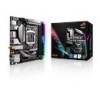Asus ROG Strix Z270I Gaming STRIX Z270I GAMING BIOS ManualEnglish - Page 19
DRAM Frequency [Auto], EPU and Performance Mode [Auto], CPU SVID Support [Auto], DRAM Timing Control
 |
View all Asus ROG Strix Z270I Gaming manuals
Add to My Manuals
Save this manual to your list of manuals |
Page 19 highlights
DRAM Frequency [Auto] This item allows you to set the memory operating frequency. The configurable options vary with the BCLK (base clock) frequency setting. Select the auto mode to apply the optimized setting. Configuration options: [Auto] [DDR4-800MHz] - [DDR4-4266MHz] Selecting a very high memory frequency may cause the system to become unstable! If this happens, revert to the default setting. TPU This item allows you to automatically overclock the CPU and DRAM frequencies and voltage for an enhanced system performance. [Keep Current Settings] Keep the current settings without changing anything. [TPU I] Applies air cooling overclocking conditions. [TPU II] Applies water cooling overclocking conditions. Ensure to use water cooling device before selecting [TPU II]. EPU and Performance Mode [Auto] EPU and Performance Mode lets you configure the power usage to boost or enhance system performance. [Auto] [Max Power-Saving Mode] Automatically adjusts the power usage based on the system load. Enables all power-saving settings for maximum energysaving condition. [EPU Mode] [Performance Mode] Lowers the CPU core/cache voltage for the best energysaving condition. Disables all power-saving settings to achieve a high system performance. CPU SVID Support [Auto] Disabling SVID Support stops the processor from communicating with the external voltage regulator. Configuration options: [Auto] [Disabled] [Enabled] DRAM Timing Control The subitems in this menu allow you to set the DRAM timing control features. Use the and keys to adjust the value. To restore the default setting, type [auto] using the keyboard and press the key. Changing the values in this menu may cause the system to become unstable! If this happens, revert to the default settings. ASUS STRIX Z270I GAMING BIOS Manual 19















